Linksys Extender Setup
In the digital era, a robust and far-reaching Wi-Fi network is essential for everything from streaming entertainment to participating in virtual meetings or simply surfing the internet. 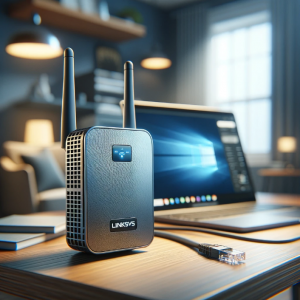 The role of a Linksys extender setup becomes crucial in achieving this connectivity.
The role of a Linksys extender setup becomes crucial in achieving this connectivity.
A Linksys range extender, or Wi-Fi booster, serves to amplify your existing Wi-Fi signal, extending its reach to eliminate dead zones and areas of weak signal. By following our detailed guide on Linksys wireless range extender setup, you can ensure comprehensive Wi-Fi coverage throughout your home or office.
Our guide is crafted to guide you through the entire process of setting up your Linksys extender. From unboxing the device to optimizing its settings for peak performance, our step-by-step instructions cater to both tech-savvy users and those new to networking devices.
As we delve into the intricacies of Linksys extenders, you’ll discover how to enhance the coverage and performance of your Wi-Fi network. Stay with us to learn how to make the most of setting up Linksys extender efficiently.
Basics of Linksys Wireless Range Extender Setup
Linksys wireless range extenders are designed to improve the reach and performance of your Wi-Fi network. These devices work by capturing the signal from your router and rebroadcasting it further, effectively expanding your Wi-Fi coverage. This ensures seamless connectivity throughout your home or office, even in areas that previously had weak or no signal.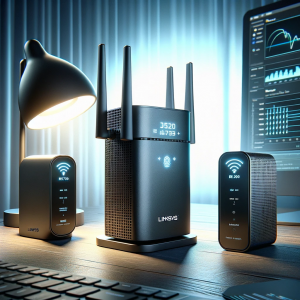
-
How Do Linksys Extenders Work?
The operation of a Linksys extender is relatively simple. Once the process of Linksys wireless extender setup is done, the extender connects to your router’s Wi-Fi network. It then amplifies and rebroadcasts the signal to areas where the Wi-Fi is weak or non-existent. This process is facilitated by the extender’s antennas, which help in spreading the signal more effectively.
-
Types of Linksys Extenders
Linksys offers a variety of extenders to cater to different needs and environments. Some popular models include:
-
-
Linksys RE7000 Max-Stream AC1900+ Wi-Fi Range Extender:
-
Ideal for large homes, this Linksys extender supports seamless roaming and can extend your Wi-Fi up to 10,000 square feet.
-
-
Linksys RE6400 AC1200 Boost Ex Wi-Fi Range Extender:
-
A great choice for medium-sized homes, offering easy setup and coverage of up to 7,500 square feet.
-
-
Linksys RE6300 AC750 Boost Wi-Fi Range Extender:
-
Perfect for smaller spaces, this wifi repeaters provides coverage of up to 6,500 square feet and is compatible with all Wi-Fi routers.
-
Benefits of Using a Linksys Extender
-
Eliminates Dead Zones:
-
By extending the Wi-Fi signal, Linksys extenders ensure that every corner of your space has access to a strong and reliable connection.
-
-
Enhanced Speed and Performance:
-
These wifi repeaters not only extend the coverage but also help in maintaining optimal speed and performance throughout the network.
-
-
Easy Linksys wireless extender Setup:
-
Linksys extenders are designed for easy installation, allowing you to quickly enhance your Wi-Fi network without the need for complex configurations.
In the following sections, we’ll guide you through the process of a Linksys wireless range extender setup, ensuring that you can enjoy an uninterrupted and robust Wi-Fi experience.
Preparation for Linksys Extender Setup
Before you begin enhancing your Wi-Fi network with a Linksys extender, it’s crucial to ensure that you’re well-prepared for a smooth Linksys extender setup. Familiarizing yourself with the essential Linksys extender settings and having all the necessary components ready will facilitate a hassle-free installation.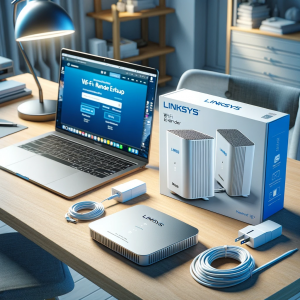
-
Checklist for a Successful Linksys WiFi Repeater Setup
-
Linksys Extender Compatible Router:
-
Verify that your existing repeater is compatible with the Linksys extender you’ve chosen. Most Linksys extenders are compatible with any Wi-Fi router, but double-checking is always wise.
-
-
Stable Internet Connection:
-
A stable and active Internet access is necessary for the initial configuration of your Linksys extender.
-
-
Linksys Extender:
-
Have your Linksys extender unboxed and ready, along with its power adapter and any other accessories that come with it.
-
-
Access to a Web Browser:
-
You’ll require a web-browsing device, like a laptop, smartphone, or tablet to access the Linksys extender’s web-based setup page.
-
-
Ethernet Cable (Optional):
-
While not always necessary, having an Ethernet cable can be useful for a wired setup or troubleshooting purposes.
-
Pre-Setup Considerations for Linksys wireless extender setup
-
Placement Of Linksys Extender:
-
Position your Linksys extender halfway between your router and the location where better WiFi coverage is required. Avoid placing the extender too close to large appliances or metal objects, as these can interfere with the signal.
-
-
Firmware Update:
-
Ensure that your router’s firmware is up-to-date. Sometimes, outdated firmware results in incompatibilities with extenders.
-
-
Linksys Extender Network Information:
-
Have your Wi-Fi network name (SSID) and password readily available, as you’ll need these during the Linksys extender setup process.
By ensuring that you have all the necessary components and information, you can streamline the setup process and avoid any potential issues. In the next section, we’ll dive into the step-by-step guide for setting up a Linksys extender, covering both the WPS method and the manual setup through the web-based interface.
Step-by-Step Guide for Setting up a Linksys Extender
-
Setting up a Linksys Extender:
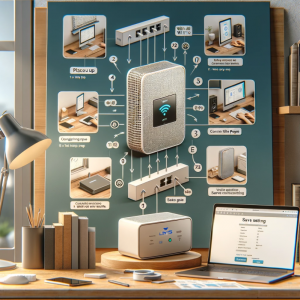
Linksys extender is a straightforward process that can significantly enhance your Wi-Fi coverage. These guidelines will help you to ensure a successful Linksys WiFi extender setup and enjoy seamless connectivity throughout your space.
-
Placement for Linksys wireless Extender setup:
Place your Linksys extender halfway between your router and the area with weak Wi-Fi signal. Ensure it’s within the range of your router’s signal.
-
Powering Up the Extender:
Plug your Linksys extender into an electrical outlet and wait for power LED to stabilize. This indicates that the extender is ready for setup.
-
Connecting to the Extender’s Network:
Utilizing a computer or mobile device, look for available Wi-Fi networks and connect to the extender’s default network, usually named “Linksys Extender Setup.”
-
Accessing the Linksys Extender Setup Page:
Open your favorite browser and type “http://extender.linksys.com” in the address bar. This will take you to the Linksys extender’s setup page and follow on-screen instructions to begin the Linksys extender setup
-
Configuring the Extender:
Select your home Wi-Fi network from the available networks list, then, when prompted, enter the password and customize the Linksys extender settings, such as the password and network name (SSID), matching your preferences.
-
Finalizing the Linksys Extender Setup:
Once you’ve configured the Linksys extender settings, save them and wait for the extender to reboot. This may take a few minutes. After the reboot, reconnect your devices to the newly extended Wi-Fi network using the updated network credentials.
-
Testing the Connection:
Test the Wi-Fi signal in previously weak signal areas to ensure the extender is operating as intended. There should be a noticeable increase in signal strength and coverage.
By following these steps for setting up a Linksys extender, you can extend your Wi-Fi coverage and enjoy a stronger, more reliable network in every corner of your home or office. These steps are also important for Linksys WiFi repeater setup.
Troubleshooting Common issues during Linksys Extender Setup
Encountering issues with your Linksys extender not working can be frustrating, but most problems can be resolved with some simple troubleshooting steps. Here are some common Linksys extender setup issues and their solutions to help you get your Linksys extender back on track.
-
Linksys Extender Not Connecting to Router:
Ensure that your extender is placed within the range of your router’s Wi-Fi signal. If the distance is too great, the extender may not be able to connect. Try positioning the extender nearer the router and attempt the Linksys extender setupprocess again.
-
Linksys Extender Connected but No Internet Access:
Verify whether the internet is linked to your router. If the router is working fine, try resetting the Linksys extenderand going through the setup process again. Make sure you type the correct Wi-Fi password during setup.
-
Unable to Access the Setup Page:
If you can’t access the Linksys extender’s setup page, make sure that your device is connected to the extender’s Wi-Fi network. Clear your browser’s cache and try to access the setup page using a different web browser or device.
-
Linksys Extender’s LED Lights Blinking or Not Stable:
Blinking lights on the extender can indicate that it’s booting up, updating firmware, or experiencing connectivity issues. Wait a few minutes for the lights to stabilize. If they continue blinking, try to reset Linksys extenderand reconfigure it.
-
Forgot Linksys Extender’s Admin Password:
If you’ve forgotten the admin password for your Linksys extender, you’ll need to reset Linksys extenderto its factory default settings. This can usually be done by pressing and holding the reset button on the extender for about 10 seconds.
By addressing these common issues, you can troubleshoot and resolve most problems related to your Linksys extender not working.
Optimizing the Performance of Linksys Extender
To ensure that your Linksys range extender delivers the best possible performance, it’s crucial to optimize its settings according to your network’s specific needs. Here are some tips to help you fine-tune your Linksys range extender settings for optimal performance.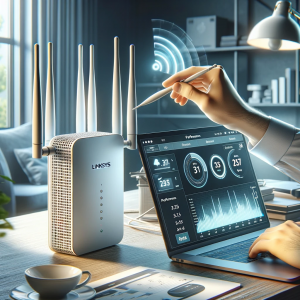
-
Linksys Extender Placement is Key:
Place your Linksys extender in a location that is equidistant between the router and the area with weak signal strength. Avoid placing it near metal objects, microwaves, or cordless phones having the potential to disrupt the signal.
-
Linksys Extender’s Update Firmware Regularly:
Keep your Linksys extender’s firmware updated to the latest version. Firmware updates often include performance improvements, bug fixes as well as additional features that can improve the functionality of your extender.
-
Linksys Extender Customize WiFi Settings:
- If you’re experiencing interference or slow speeds, try changing the WiFi channel on your extender. Use a WiFi analyzer tool to find the least crowded channel in your area.
- If your Linksys extender is dual-band, ensure that it’s set to the appropriate frequency band (2.4 GHz for wider coverage or 5 GHz for faster speeds) based on your needs.
-
Secure Your Network:
- For added security, change the default admin password of your Linksys extender to a strong, unique password. This prevents unauthorized access to your Linksys extender settings.
- Ensure that your extender’s Wi-Fi network is secured with WPA2 encryption, which provides robust protection against unauthorized access.
-
Monitor and Test Your Linksys Extender Network:
- Conduct regular speed tests to monitor the performance of your extended network. This can help you identify any issues early and make necessary adjustments.
- Keep an eye on the number of devices connected to your Linksys extender. The network may get overloaded with too many devices and reduce the performance.
By adjusting your Linksys range extender settings and by adhering to these optimization guidelines, you will ensure that your extender provides the best possible Wi-Fi coverage and performance for your home or office network.
Security Considerations regarding Linksys WiFi Extender Login
When Linksys WiFi extender setup takes place, prioritizing security is essential. Protecting your network against unauthorized access is crucial for maintaining the secrecy and integrity of your data. Here are some critical security considerations to keep in mind.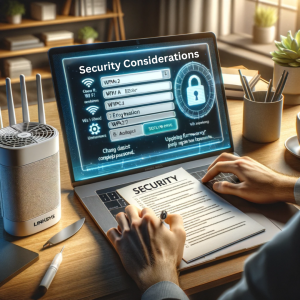
-
Change Default Login Credentials:
Initially, your Linksys extender comes with default login credentials, which are often generic and easily guessable. Enhance security by changing the default Linksys WiFi extender logincredentials to a unique username and a strong, complex password. This step is crucial for securing your network.
-
Enable WPA2 Encryption:
WPA2 (Wi-Fi Protected Access 2) is the standard encryption protocol for Wi-Fi networks, offering a higher level of security than its predecessors, WPA and WEP. Configure your Linksys extender to use WPA2 encryption for its Wi-Fi network to protect data transmission from eavesdropping and unauthorized access.
-
Keep Firmware Updated:
Device manufacturers often release firmware updates that include security patches and enhancements. Make sure to routinely scan for and apply firmware updates on your Linksys extender to protect against known vulnerabilities and improve overall security.
-
Disable WPS (Wi-Fi Protected Setup):
While WPS simplifies connecting devices to your Wi-Fi network, it can pose a security risk due to potential vulnerabilities. Disable WPS on your Linksys extender to reduce the risk of unauthorized access.
-
Monitor Your Extender’s Network:
Monitoring the gadgets that are attached to your network can help you find any illegal access. Continually check the list of devices that are linked to your extender’s network. Take action to secure your network if you notice any unfamiliar devices.
By considering these security measures and changing your Linksys Wi-Fi extender login credentials, you may greatly improve your Wi-Fi network’s security and safeguard your personal information.
FAQs
Q1. Why is my Linksys Wi-Fi extender not working?
- A1. Check if the extender is properly plugged in and receiving power. Ensure it’s within the range of your router’s Wi-Fi signal and that the Linksys extender settings are correctly configured.
Q2. How do I reset Linksys extender?
- A2. To reset Linksys extender, press and hold the reset button on the device for about ten seconds. By doing this, the extender will return to its original factory configuration.
Q3. Can I connect multiple devices to my Linksys extender?
- A3. Yes, you are able to link several devices to your Linksys extender. However, keep in mind that the more devices connected, the more the bandwidth is shared, which may affect overall performance.
Q4. How do I update the firmware on my Linksys extender?
- A4. Log in to the Linksys extender’s web interface and navigate to the firmware update section. Look for any changes that are available and adhere to the instructions to install them.
Q5. Why can’t I access the Linksys extender setup page?
- A5. To access the Linksys extender setup page, make sure that your device is connected to the extender’s Wi-Fi network. Try clearing your browser’s cache or using a different browser. If the issue persists, reset Linksys extender and try again.
Q6. How can I strengthen the signal strength of my Linksys extender?
- A6. Place the extender in an optimal location, away from obstacles and interference sources. Also, consider adjusting the Linksys extender settings for better performance.
Q7. What should I do if my Linksys extender is connected but there’s no internet access?
- A7. Check if your router is linked to the internet. If the router is working fine, try restarting both the router and the extender. Ensure that the correct Wi-Fi network and password are configured on the extender.
Q8. Can I use my Linksys extender with a non-Linksys router?
- A8. Yes, Linksys extenders are generally compatible with routers from other manufacturers. Ensure that the router’s Wi-Fi network is functioning correctly and follow the Linksys extender setup instructions for your Linksys extender.
Q9. How do I change the WiFi network name (SSID) and password on my Linksys extender?
- A9. Login Linksys extender web interface and navigate to the wireless settings section. Here, you can change the SSID and password for your extended network.
Q10. What should I do if my Linksys extender’s lights are blinking?
- A10. Blinking lights can indicate various statuses, such as booting up, updating firmware, or connectivity issues. Refer to your extender’s manual for specific light status meanings and troubleshooting steps.
Conclusion
In conclusion, a proper Linksys WiFi range extender setup is essential for maximizing the coverage and performance of your Wi-Fi network. By following the steps outlined in this guide, you can extend your Wi-Fi signal to reach every corner of your home or office, ensuring seamless connectivity for all your devices.
The benefits of a well-configured Linksys extender go beyond just eliminating dead zones. Additionally, it offers a more dependable and stable connection, enabling you to take advantage of seamless surfing, gaming, and streaming. Moreover, by optimizing the Linksys extender settings and regularly updating its firmware, you can maintain optimal performance and security. Remember, the key to a successful Linksys WiFi range extender setup lies in careful planning, from choosing the right location for your extender to customizing its settings to suit your network’s needs. And should you encounter any issues, the troubleshooting tips and FAQs provided in this guide are here to help you resolve them.
We hope this guide has been informative and helpful in setting up a Linksys extender. By enhancing your WiFi network’s coverage and performance, you can enjoy a seamless and connected digital experience.
To know more about Linksys Extender setup and resolve its related issues, visit Linksys Router Support Page.

Joshua wilson
How can I resolve connectivity issues after completing the Linksys extender setup but the device still isn’t working as expected?
Support Admin
If you’ve completed the Linksys WiFi extender setup and are encountering connectivity issues with the device not working as anticipated, there are several troubleshooting steps you can take. First, ensure that the Linksys extender is within optimal range of your router to maintain a strong signal connection. It’s essential to check the extender’s LED indicators for any error signals. If the device is too far from the router, it may not receive a strong enough signal to broadcast efficiently. Try relocating the extender to a more central location within your home. Additionally, check if the extender’s firmware is up to date through the Linksys extender login page, as outdated firmware can cause connectivity issues. If these steps do not resolve the problem, performing a reset on the Linksys extender might be necessary. Press and hold the reset button for 10 seconds to restore factory settings, and then go through the Linksys wireless range extender setup process once again.
Michael nguyen
During the Linksys WiFi range extender setup, I’m unable to access the extender.linksys.com setup page. What should I do?
Support Admin
If you’re having difficulty accessing the extender.linksys.com setup page during your Linksys WiFi range extender setup, ensure your device is correctly connected to the Linksys extender’s default WiFi network. Connectivity issues might prevent you from reaching the setup page. Try restarting your device and the Linksys extender, then reconnect to the extender’s network. Clearing your web browser’s cache and cookies can also help resolve this issue. If the problem persists, attempt using a different web browser or a different device altogether to access the setup page. In some cases, temporarily disabling any VPN connections on your device might also prevent access issues. If all else fails, a factory reset of the Linksys extender could be necessary to start the setup process from scratch.
Barbara anderson
After setting up a Linksys extender, my devices experience slow internet speeds when connected through the extender. How can I improve this?
Support Admin
Experiencing slow internet speeds on devices connected through a Linksys extender after completing the Linksys wireless extender setup can be frustrating. To enhance performance, first, ensure that the extender is strategically placed to balance the distance between your router and the areas needing improved coverage without being too close or too far from the router. Metal objects, appliances, and thick walls can interfere with the signal, so consider the extender’s location relative to these obstacles. Use a WiFi analyzer tool to identify the least congested channels and adjust your Linksys range extender settings accordingly. Additionally, updating the firmware through the Linksys WiFi extender login page can provide performance enhancements and security fixes. If your extender supports dual-band operation, distributing devices between the 2.4GHz and 5GHz bands can also alleviate congestion and improve speeds.